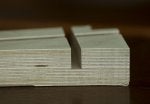If I need to cut a simple square notch, I'm always troubled whether to use a router or dado blades on my table saw. I like the router in that it gives me 3 perfectly smooth sides, whereas my blades give me a grooved top side. My router table is home-made. It's good for bits that align themselves with the edge of the wood like flush cut or roundover bits, but if I'm cutting a groove and have to rely on my fence, well the fence isn't that reliable to stay in place, and a router wants to push the wood sideways. Also, my groove size is limited by the bits I have. The dado blades will let me cut a groove that is 29/64" if that's what I need.
I *could* buy a professional router table, but they ain't cheap, and I'd like to do a lot more research on that before pulling the trigger.
My dado blade set is a simple steel Vermont American set that I bought many many years ago when I was poor and ignorant. So I was wondering... Would a newer, better set of dado blades give me a better cut, approaching if not quite as clean as a router bit? I don't want to throw money at the issue if it's not going to help me that much.
I *could* buy a professional router table, but they ain't cheap, and I'd like to do a lot more research on that before pulling the trigger.
My dado blade set is a simple steel Vermont American set that I bought many many years ago when I was poor and ignorant. So I was wondering... Would a newer, better set of dado blades give me a better cut, approaching if not quite as clean as a router bit? I don't want to throw money at the issue if it's not going to help me that much.






